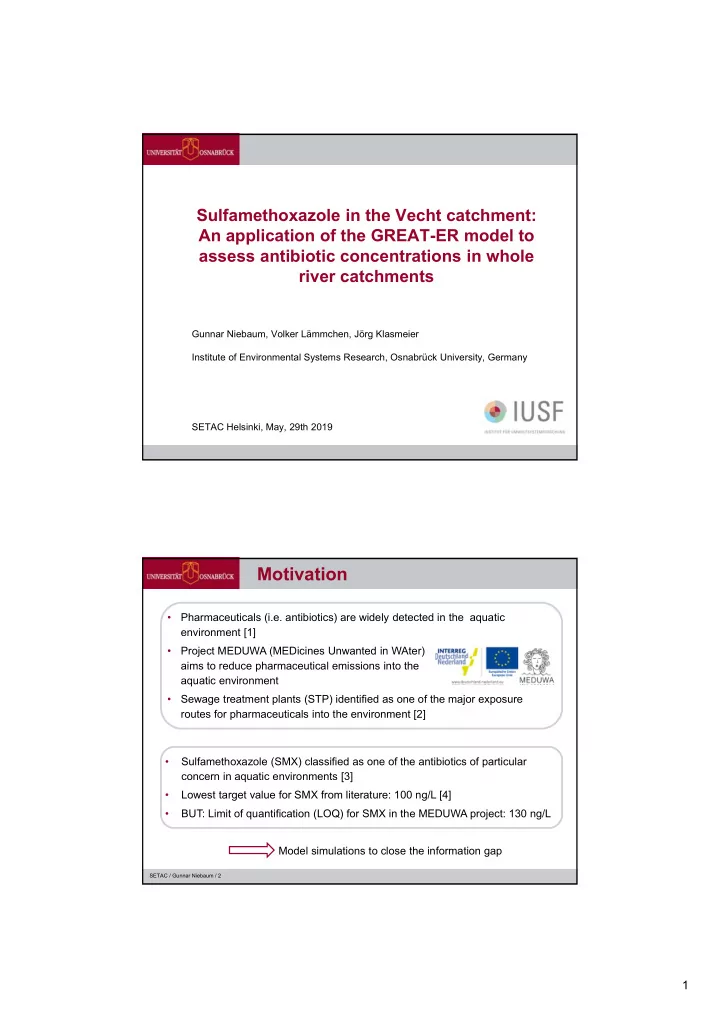

Sulfamethoxazole in the Vecht catchment: An application of the GREAT-ER model to assess antibiotic concentrations in whole river catchments Gunnar Niebaum, Volker Lämmchen, Jörg Klasmeier Institute of Environmental Systems Research, Osnabrück University, Germany SETAC Helsinki, May, 29th 2019 Motivation • Pharmaceuticals (i.e. antibiotics) are widely detected in the aquatic environment [1] • Project MEDUWA (MEDicines Unwanted in WAter) aims to reduce pharmaceutical emissions into the aquatic environment • Sewage treatment plants (STP) identified as one of the major exposure routes for pharmaceuticals into the environment [2] • Sulfamethoxazole (SMX) classified as one of the antibiotics of particular concern in aquatic environments [3] • Lowest target value for SMX from literature: 100 ng/L [4] • BUT: Limit of quantification (LOQ) for SMX in the MEDUWA project: 130 ng/L Model simulations to close the information gap SETAC / Gunnar Niebaum / 2 1
Objectives 1. Prediction of spatially explicit concentrations of SMX in the Vecht catchment with the GREAT-ER model 2. Determine risk characterisation ratios (RCR) to frame the risk 3. Demonstrate that GREAT-ER is an appropriate tool for a priori evaluation of management scenarios SETAC / Gunnar Niebaum / 3 Vecht catchment • Cross-border (GER - NL) • Catchment size: 6,224 km 2 • Mean discharge at outlet: 44 m 3 /s • 53 sewage treatment plants serving 1.2 million inhabitants SETAC / Gunnar Niebaum / 4 2
The model GREAT-ER • Geography-referenced regional exposure assessment tool for European rivers • Development started in 1997 for ‘down-the-drain-chemicals‘ [5,6] • Successfully applied for pharmaceuticals: e.g. β-blocker in Glatt valley, Switzerland; Diclofenac in Ruhr basin [7,6] • Geo-information system (GIS) application • Steady state, mass balance model SETAC / Gunnar Niebaum / 5 Simulation Monte-Carlo approach: • 10,000 deterministic simulations • Parameters for each run from defined probability distribution representing natural variability (e.g. discharge) and/or parameter uncertainty Model parameters: • National per capita (hospital per patient) consumption (NL, GER) • Excretion rate • Sewage treatment plant removal efficiencies • Degradation (photolysis) rate SETAC / Gunnar Niebaum / 6 3
Results • Measured environmental concentration (MEC) < LOQ at all sampling sites • Mean predicted concentrations (PEC) agree well • PEC in river Vecht at the border (17 ng/L) well below lowest literature target value (100 ng/L) SETAC / Gunnar Niebaum / 7 Results – Risk assessment Min. EQS PNEC ecotox [8] PNEC resistance [9] Max. RCR a 6.68 1.13 0.01 PEC Mean Target value 69 (7.11%) 1 (0.10%) 0 (0.00%) exceedance [km] b Max. RCR a 18.98 3.22 0.12 PEC 95 th Target value percentile 206 (21.23%) 10 (1.03%) 0 (0.00%) exceedance [km] b a RCR = PEC/EQS or PEC/PNEC RCR = Risk Characterisation Ratio, PEC = Predicted Environmental Concentration, EQS = Environmental Qulality Standard, PNEC = Predicted No Effect Concentration b Cumulated flow length where the target value is exceeded; percentages apply for the contaminated flow length SETAC / Gunnar Niebaum / 8 4
Results – Measures Shaded area spans the range of 5th and 95th percentile of base scenario (grey) and quartenary treatment scenario (red) SETAC / Gunnar Niebaum / 9 Conclusion GREAT-ER is a valuable tool to • characterize the risk of the antibiotic Sulfamethoxazole in a whole river catchment • identify important emission sources • evaluate different mitigation measures SETAC / Gunnar Niebaum / 10 5
Outlook • Summer scenarios water in the Netherlands is pumped via canals into different tributaries • Simulations for other pharmaceuticals (e.g. Carbamazepine, macrolides) • Simulations for (multiresistant) E. coli • Evaluation by comparison with data from monitoring campaign SETAC / Gunnar Niebaum / 11 References & Acknowledgements References [1] Loos R, Gawlik BM, Locoro G, Rimaviciute E, Contini S, Bidogli G. 2009. EU-wide survey of polar organic persistent pollutants in European river waters. Environ. Pollut. 157 561-568. [2] Ternes TA, Joss A, Siegrist, H. 2004. The complexity of these hazards should not be underestimated. Environ Sci Technol 38: 392-399A. [3] Johnson AC, Keller V, Dumont E. 2015. Assessing the concentrations and risks of toxicity from the antibiotics ciprofloxacin, sulfamethoxazole, trimethoprim and erythromycin in European rivers. Sci Total Environ 511: 747-755. [4] Girbig, AK, Steffen, D. 2013. Untersuchung niedersächsischer Oberflächengewässer auf bestimmte Humanarzneimittel (Carbamazepin, Diclofenac und Sulfamethoxazol). Niedersächsischer Landesbetrieb für Wasserwirtschaft, Küsten-und Naturschutz (NLWKN). Hildesheim. [5] Feijtel T, Boeije G, Matthies M, Young A, Morris G, Gandolfi C, ... , Schroder R. 1997. Development of a geography-referenced regional exposure assessment tool for European rivers-GREAT-ER contribution to GREAT-ER #1. Chemosphere 34 (11): 2351-2373. [6] Kehrein N, Berlekamp B, Klasmeier J. 2015. Modeling the fate of down-the-drain chemicals in whole watersheds: New version of the GREAT- ER software. Environ Model Softw 64: 1-8. [7] Alder AC, Schaffner C, Majewsky M, Klasmeier J, Fenner K. 2010. Fate of β-blocker human pharmaceuticals in surface water: comparison of measured and simulated concentrations in the Glatt Valley Watershed, Switzerland. Water res 44 (3): 936-948. [8] Ferrari B, Mons R, Vollat B, Fraysse B, Paxēaus N, Giudice RL, …, Garric J 2004. Environmental risk assessment of six human pharmaceuticals: are the current environmental risk assessment procedures sufficient for the protection of the aquatic environment?. Environ Toxicol 23(5): 1344-1354. [9] Bengtsson-Palme J, Larsson DJ. 2016. Concentrations of antibiotics predicted to select for resistant bacteria: Proposed limits for environmental regulation. Environ Int 86: 140-149. Acknowledgements This work was supported by the European Union and INTERREG VA Deutschland-Nederland under the project MEDUWA-Vecht(e) (project number 142118 Monitoring data was provided by WETSUS - european centre of excellence for sustainable water technology Removal efficiencies obtained by the project Removal efficiencies of micropollutants at STP in the region Rijn-Oost SETAC / Gunnar Niebaum / 12 6
Recommend
More recommend